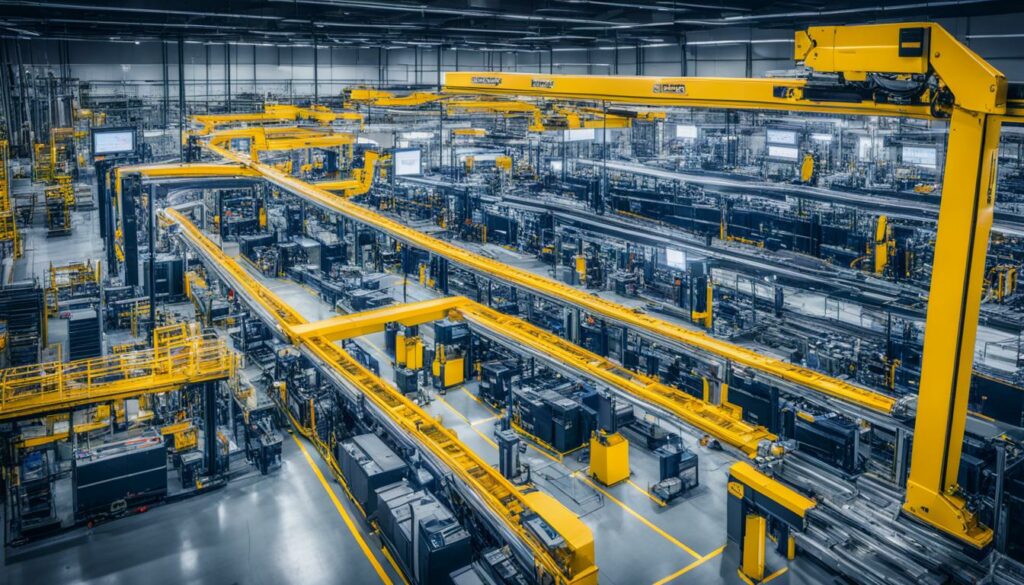Did you know that early adopters of AI in supply chain management have seen a 15% reduction in logistics costs? They also saw a 65% enhancement in service levels. Traditional logistics methods are no longer enough for today’s global markets. AI for supply chain optimization offers new solutions that make operations more efficient and effective.
With the digital transformation of supply chains, AI not only makes processes smoother. It also gives companies predictive analytics to quickly meet market demands. From tracking shipments in real-time to managing risks better, AI is changing how companies handle their supply chains. This makes AI a must-have for staying competitive in today’s fast market.
Key Takeaways
- AI helps reduce logistics costs significantly while improving service quality.
- Predictive analytics is key for adapting to real-time market shifts.
- Efficient risk management with AI can safeguard against supply chain disruptions.
- Digital transformation enhances overall supply chain efficiency.
- Implementing AI tools allows for better decision-making and resource allocation.
- Real-time tracking improves transparency and customer satisfaction.
The Role of AI in Modern Supply Chains
Artificial intelligence is changing how businesses work, making them more efficient and adaptable. With AI, companies can now streamline processes and make better decisions. This technology helps with automation in logistics, cutting down on mistakes and offering insights for better improvement.
Arvist leads in using AI to help, not replace, human skills. They add AI to current systems, focusing on key areas one step at a time. This way, they avoid big disruptions and make operations work better.
AI tools like computer vision and digital twins are great for improving quality and safety in warehouses. For example, a big car maker used AI to create a system that caught quality problems early, saving millions. Another company used AI to make their plants safer, cutting down on accidents worldwide.
The move towards more automation in logistics is clear, with supply chains planning to use more machines in the next five years. Spending on Industrial Internet of Things (IIoT) platforms is going up, showing how important AI is in logistics. These changes help track inventory in real-time, predict demand, and manage inventory better, leading to less waste and more productivity.
As AI becomes more part of supply chains, it makes operations better and helps with big challenges like natural disasters and new laws. For example, the Uyghur Forced Labor Prevention Act makes companies deal with complex labor issues. This shows how smart, flexible supply chains are needed.
Understanding Supply Chain Challenges
Modern supply chains face many supply chain challenges that slow them down. Fluctuations in demand, or demand variability, make it hard to plan and manage inventory. Finding the right balance between supply and demand helps reduce waste and keeps customers happy.
Supply chains change all the time, making things harder. Things like geopolitical events and economic changes add to the trouble. Sadly, only about one-third of companies check themselves to find where they can do better. This lack of checking can lead to waste and more risks.
Supply chain leaders often don’t share the same goals. Only 25 percent think their goals match up with their system integrators’. This shows the need for better decision-making. Also, many companies struggle with operational risks because they’re not ready for skills gaps. Only 13 percent of executives feel they’re prepared.
Companies are starting to use artificial intelligence to tackle these problems. AI helps make supply chains better by improving forecasting, making logistics smoother, and finding waste. AI has shown it can cut costs, manage inventory better, and improve service levels.
Using AI solutions cuts costs and gives companies an edge by analyzing data in real-time. It also helps understand what customers want. As companies use these new technologies, they might find it easier to handle supply chain challenges.
For more on how AI helps with these issues, check out this resource on AI advancements.
AI for Supply Chain Optimization
Artificial intelligence has changed how supply chains work, making them more efficient and cutting costs. AI helps make smarter decisions by using lots of data. This tech helps companies plan and do things better.
Benefits of AI-Driven Decision-Making
More companies are using AI to make their supply chains better. Machine-learning helps manage inventory and guess demand better. This means they work more efficiently.
Companies like Amazon and Walmart use AI to make their logistics better. They use natural language processing and predictive analytics.
Reducing Operational Costs through AI
AI helps businesses save money by making things more efficient. Automated systems with robotics cut down on mistakes. This makes supply chains work better.
Companies like Echo Global Transportation use these techs to make shipping better. They get more accurate and save money. AI also helps manage inventory well, keeping it just right for customers.
| Company | AI Technology Used | Benefit |
|---|---|---|
| Amazon | Machine Learning | Improved Inventory Management |
| Walmart | Natural Language Processing | Enhanced Demand Forecasting |
| Echo Global Transportation | AI Tools for Transportation | Cost Reduction |
| C3 AI | Predictive Analysis | Minimized Inventory Levels |
Predictive Analytics and Demand Forecasting
Predictive analytics is key in the supply chain for accurate demand forecasting. By using machine learning, companies can look at past sales, market trends, and customer habits. This helps them predict future demand well. These tools make forecasting smarter, helping businesses manage their stock better and avoid too much or too little stock.
Methods like regression analysis, time-series analysis, and neural networks are crucial in predictive analytics. They help spot trends and patterns in past data. This lets companies adjust their plans. Natural language processing (NLP) also plays a big part by looking at lots of feedback and social media. It helps make demand forecasts more accurate by using real-time insights.
IoT sensors are another big help, collecting data on things like how much stock is left and what customers like. This info helps keep demand forecasts right and makes operations more efficient. Image recognition helps too by looking at product pictures and spotting what customers are into.
Using these AI tools brings many benefits:
- Increased accuracy: AI gets better at predicting by learning from past data.
- Cost savings: Managing stock better cuts down on costs and reduces the risk of products going out of style.
- Enhanced customer service: Having products in stock makes customers happy and helps sell more.
- Competitive advantage: AI helps businesses quickly adapt to changes in the market.
- Logistics optimization: AI finds the best ways to move goods.
This advanced forecasting system uses many AI tools to help businesses handle complex demands. The constant analysis of data helps make better decisions in making products, managing stock, and shipping goods.
Predictive analytics in the supply chain shows how AI can really change things. By combining data, machine learning, and real-time analysis, businesses can make smarter choices. This leads to big growth in making supply chains better.
| Technique | Description | Application |
|---|---|---|
| Regression Analysis | Identifies relationships between variables for predicting outcomes | Forecasting sales based on historical data |
| Time-Series Analysis | Analyzes data points collected over time to identify trends | Planning inventory levels based on seasonal patterns |
| Neural Networks | Simulates human brain processes to recognize complex patterns | Adjusting forecasts for emerging product trends |
| Natural Language Processing | Processes human language and sentiment from various data sources | Updating forecasts based on customer feedback |
| Image Recognition | Analyzes visual content to understand market preferences | Improving product demand accuracy based on observed consumer behavior |
| IoT Data Collection | Gathers real-time metrics from supply chain operations | Enhancing accuracy in current demand forecasts |
Enhancing Inventory Management with AI
Using AI in inventory management is a big step forward. It makes things more efficient and accurate. Businesses can use advanced analytics to keep up with market changes easily. Old inventory systems need manual tracking, which slows things down.
Now, 43% of small businesses in the USA still track inventory by hand. AI helps manage inventory by automating key tasks. This cuts down on mistakes and lets teams focus on important work.
Intelligent Inventory Control
AI changes how we manage inventory for the better. It uses predictive analytics to guess demand by looking at past sales and market trends. This means having the right stock levels, which saves money and makes supply chains stronger.
Companies that use AI can cut costs by 9% to 4%, which could double their profits. AI helps create inventory plans that fit specific products and trends. This keeps businesses quick and competitive.
Real-Time Data Analysis
Real-time inventory tracking gives businesses instant stock updates. This helps them make fast decisions. AI looks at inventory and demand data all the time, helping with smart restocking.
This makes supply chains clearer, letting companies quickly adapt to changes. Companies using AI well get better at what they do and spend less on overhead. AI helps reduce waste and make inventory management more eco-friendly.
| Benefit of AI in Inventory Management | Description |
|---|---|
| Enhanced Supply Chain Efficiency | Streamlined processes through automation and accurate forecasting. |
| Cost Reduction | Lower inventory carrying costs and optimized reorder quantities. |
| Real-Time Visibility | Instant insights into stock levels allowing for prompt responses. |
| Improved Operational Efficiency | Freeing up staff time and minimizing errors through automation. |
| Sustainability | Minimizing waste and environmental impact through improved inventory controls. |
Machine Learning Applications in Supply Chain
Machine learning is changing how companies manage their supply chains. It helps with inventory, logistics, and working with suppliers. The need for better planning is clear, especially after recent global events like the Covid-19 pandemic and trade wars.
Optimal machine learning (OML) is a new way to fix old planning problems. It uses a special engine to look at lots of data fast. This engine gives quick advice on how much to make and ship.
Old forecasting can cause delays and wrong inventory levels. Machine learning helps fix this by making better predictions. This can lead to better production planning and forecasting, as McKinsey suggests.
The following table shows the good and bad sides of using machine learning in supply chains:
| Advantages | Challenges |
|---|---|
| Enhanced productivity | Fluctuations in demand |
| Improved communication | Inadequate inventory planning |
| Efficient warehouse management | Order backlogs |
| Reduced labor costs | Uncertainties in logistics |
| Advanced robotics and automation | Communication gaps |
| Improved warehouse stock management | Supply shortages |
Machine learning helps find and fix problems in AI-powered supply chains. For example, it can cut fuel costs and make sure deliveries are on time by looking at lots of data. As technology gets better, companies that use it will likely get more efficient and save money.

Real-Time Visibility and Tracking Solutions
Over 70% of logistics companies struggle with limited visibility in the supply chain. Traditional tracking systems often don’t work well together, leading to poor monitoring and high costs. Real-time tracking can solve these problems, giving a clear view of operations.
Many logistics firms use old-school manual tracking, which can lead to wrong data and trouble with the law. Less than 30% of these systems give real-time data, making it hard for businesses to handle problems quickly. This means there’s a big risk of delays and waste. Using AI can make tracking more reliable and clear throughout the supply chain.
AI brings real-time visibility, letting logistics companies know where products are and their status. Predictive analytics helps predict problems, so companies can plan ahead. This means better use of resources, smoother operations, and happier customers.
Blockchain technology also brings more trust and the ability to track things better. AI helps handle exceptions fast, which makes solving problems quicker and keeps improving things. With the huge amount of data in traditional supply chains, AI helps make things better.
Having clear supply chains is key in a world where 21% of industry pros say they don’t have visibility issues. Using AI, predictive analytics, and blockchain changes how we track and trace things. This gives companies a big edge and builds trust with stakeholders.
Predictive Maintenance and Operational Efficiency
In today’s fast-paced world, companies are turning to predictive maintenance in supply chains. They use AI to predict equipment failures and plan ahead. This approach makes machines more reliable and boosts efficiency across different sectors.
AI in predictive maintenance uses machine learning to look at past data and repair histories. It helps companies plan maintenance before problems happen. This cuts down on unplanned downtime, making supply chains run smoother and using resources better.

Using predictive maintenance can cut costs on emergency repairs and better use resources. Companies that use it see more productivity and lower costs. AI helps reduce downtime and make the most of production time.
- Enhanced System Reliability: Predictive maintenance keeps equipment running well, preventing big disruptions.
- Lower Maintenance Costs: Regular maintenance means fixing problems early, saving money.
- Improved Resource Allocation: Knowing when maintenance is needed helps use people and machines better.
- Increased Competitiveness: Companies with predictive maintenance can meet customer needs better, gaining a market edge.
| Benefits of Predictive Maintenance | Impact on Operational Efficiency |
|---|---|
| Reduces Unexpected Failures | Ensures Reliability |
| Optimizes Maintenance Scheduling | Enhances Productivity |
| Decreases Repair Costs | Lowers Operating Expenses |
| Improves Asset Utilization | Maximizes Output |
Adding predictive maintenance to supply chain management helps streamline processes. It makes operations more efficient. This leads to a well-running and quick supply chain.
Artificial Intelligence in Risk Management
Artificial intelligence is key in making risk management better in supply chains. Companies face many challenges, like unexpected problems from the pandemic and supply shortages. To tackle these, they’re turning to AI for risk management to make things smoother and more accurate.
Scenario Analysis for Proactive Strategies
AI helps with scenario analysis in supply chain management. This lets companies look at risks and plan ahead. It’s very useful when checking on suppliers and finding weak spots. AI gives insights that help in planning by looking at different scenarios and predicting outcomes. This helps companies make smart choices.
Mitigating Supply Chain Disruption Risks
Companies want to avoid disruptions by using AI to look at risks. AI spots threats in the supply chain, helping businesses get ready for surprises. With predictive and prescriptive analytics, companies can make their operations better and bounce back faster from disruptions.
| AI Application | Functionality | Benefits |
|---|---|---|
| Scenario Analysis | Evaluate potential risks and develop proactive strategies | Improved decision-making and preparedness |
| Predictive Analytics | Forecast outcomes based on historical data | Enhanced planning and risk assessment |
| Prescriptive Analytics | Recommend solutions to mitigate identified risks | Informed actions leading to effective risk management |
| Supplier Risk Management | Monitor supplier performance and assess vulnerabilities | Increased supply chain resilience and efficiency |
For more insights into the evolving role of AI in addressing contemporary challenges, visit this informative resource.
Conclusion
Artificial intelligence is changing how we manage supply chains today. It brings many benefits like better efficiency, accuracy, and flexibility. By 2025, AI will change the game, helping companies stay ahead in a fast-changing world.
Now, companies use AI and machine learning to make their supply chains better. This leads to big cost cuts and better predictions of what customers will want. For example, ThroughPut AI helped a global cement producer use trucks more efficiently, showing how AI can make a big difference.
As AI gets better, it’s key for companies to jump on board. Working together with AI can make businesses smarter and quicker. For those curious about AI’s impact on marketing, checking out AI-driven marketing strategies can show how it gives a competitive edge. The future is clear: using AI in supply chains is a must to keep up with today’s customers and stay ahead of the competition.
FAQ
How does AI optimize supply chain operations?
AI uses predictive analytics and real-time tracking to make supply chains better. It helps businesses work more efficiently, cut costs, and adapt fast to market changes.
What are the key benefits of using AI in logistics?
AI in logistics brings many advantages. It helps with better decision-making, managing inventory, finding the best routes, and keeping track in real-time. This makes supply chains more agile.
How can predictive analytics improve demand forecasting?
Predictive analytics looks at past data and market trends to forecast demand better. This lets companies keep the right amount of inventory and handle demand changes well.
What challenges does AI help address in supply chains?
AI tackles issues like unpredictable demand, complex supplier relationships, risks, and disruptions from things like global events and economic changes.
How does machine learning enhance supply chain management?
Machine learning finds patterns in big data to improve supply chain management. It helps with better route planning, picking suppliers, and making operations more efficient.
What role does real-time tracking play in supply chains?
Real-time tracking makes the supply chain more transparent. It helps businesses spot and fix problems fast, improving communication among everyone involved.
How does AI contribute to predictive maintenance in operations?
AI looks at equipment data to predict when parts might break, planning maintenance to avoid downtime. This keeps supply chains running smoothly.
In what ways does AI assist in risk management within supply chains?
AI helps manage risks by analyzing different scenarios. This lets companies prepare for and lessen the impact of disruptions and weaknesses.




